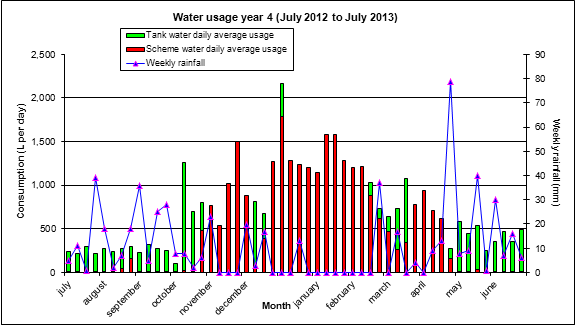It's been four years since we installed our 14,000L rain water tank, so here's the annual wrap. It was another dry year in WA, with 571mm on our block. Perth's average is supposed to be around 750mm, but the new reality is much lower. Here is the rainfall in the last four years, recorded by me on a daily basis. You can see we have a very seasonal pattern, with most rainfall in the cooler months (April to October). The average for the last four years is 634mm and we've only reached 750mm once.
Despite this we harvested and used a record 81,241L of rainwater this year, which represents 30% of our total use. This is pretty good going I think for a 14,000L tank. It means we've got through almost six tanks worth in the year. The key to this is the fact that everything is plumbed in to the tank (house and garden), so we minimise our losses to overflow by using rainwater whenever it's available. The water switch switches back to mains water when the tank is empty and switches back when it fills up.
This chart shows weekly rainfall (scale on the right axis) and our daily consumption (left axis) split into the proportions of tank and mains water (green and red). It shows the long dry period through summer when there is little rainwater available and when our consumption rises to keep our fruit and veg going in the intense summer heat. We go about 6 months of the year using predominantly rainwater.
The next chart shows how the tank level fluctuates with rainfall and usage patterns. The level stays high in winter with good rainfall and low usage, but as soon as rainfall drops and we turn on the retic the level drops sharply.
The last chart below shows our daily consumption of both rainwater and mains water for the last four years. You may think that for a sustainable minded family we use too much water (734L a day this year). I know it sounds like a lot but it's actually lower than the Perth average. In our defense we use little in the house (about 200L a day) and lots on the garden. Perth has extremely hot, dry summers and this means it takes lots of water to keep the garden going. We have 20 fruit and nut trees, lots of veges and a small lawn on our 700 sq.m block. Also, we've cut our water usage despite adding more retic to more plants recently.
Next year we hope to use a lot less too. We have just bought a new front loading washing mashine to replace our old top loader. It uses 62L per wash as opposed to about 180L, so we could save 25,000L here. And our new grey water system should save us lots, especially on the lawn. Another big saving here and we could use 50,000L less next year. I'm predicting water use of 600L a day next year. Watch this space...






Well done on the water use and harvesting. It isn't easy to think about using less when the water is on tap and you have certainly thought about it and done something about it.
ReplyDeleteOn the washing machine front; we have found that a twin tub machine uses the least water of all. With careful sorting of clothes we get four loads out of one lot of water. We wash whites and not too dirty clothes first and follow on with work clothes and grubby stuff. We rinse in a tub beside the machine. This lets us (family of 3) do a weeks' washing with 200 litres.
Are there any plans to put in another tank?
Hi Jude
ReplyDeleteGood work with the miserly water use for washing. No plans for another tank. I think 14,000L is a pretty good size for suburbia, maybe 25,000 would be better but it would take more space from the garden unless we went underground. Also, there are diminishing returns with larger tanks unless you can increase the catchment area.
That's true, I tend to forget the lack of space thing, being lucky enough to live in the bush on a 'lifestyle' block (approx 100 acres). I used to have the formula for calculating water harvesting capacity from a roof space, but its deep in the bowels of the library now. I am curious to find it again and calculate our harvesting.
ReplyDeleteWe live entirely on rain water here, so I am always looking to increase our storage capacity.